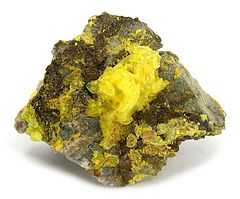Liebigite
From Wikipedia, the free encyclopedia
| Liebigite | |
|---|---|
 Liebigite crystals from the Ralston Buttes District, Jefferson County, Colorado | |
| General | |
| Category | Carbonate mineral |
| Formula (repeating unit) | Ca2(UO2)(CO3)3·11H2O |
| Strunz classification | 05.ED.20 |
| Crystal symmetry |
Orthorhombic pyramidal H-M symbol: (mm2) Space group: Bba2 |
| Unit cell | a = 16.699 Å, b = 17.557 Å, c = 13.697 Å; Z=8 |
| Identification | |
| Colour | Green to yellowish-green |
| Crystal habit | Rare as short prismatic crystals; scaly or granular, in aggregates, crusts, and films |
| Crystal system | Orthorhombic |
| Cleavage | Distinct on {100} |
| Tenacity | Brittle |
| Mohs scale hardness | 2½ - 3 |
| Luster | Vitreous, pearly |
| Diaphaneity | Transparent, translucent |
| Specific gravity | 2.41 |
| Optical properties | Biaxial (+) |
| Refractive index | nα = 1.497 nβ = 1.502 nγ = 1.539 |
| Birefringence | δ = 0.042 |
| Pleochroism | Visible: X = nearly colourless Y = Z = light yellowish green |
| 2V angle | 37° to 42° |
| Ultraviolet fluorescence | Strong green to blue-green under short and long wave UV |
| References | [1][2][3] |
Liebigite is a uranium carbonate mineral with the chemical formula: Ca2(UO2)(CO3)3·11H2O. It is a secondary mineral occurring in the oxidizing zone of uranium-bearing ores. It is green to yellow green in colour. It has a Mohs hardness of about 3. Liebigite, like some other uranium minerals, is fluorescent under UV light and is also translucent. It crystallizes in the orthorhombic system, but only rarely forms distinct crystals. It typically forms encrustations or granular aggregates.[1][2][3]
It was first described in 1848 for an occurrence in Adrianople, Edirne Province, Marmara Region, Turkey.[1] It was named for German chemist Justus von Liebig (1803–1873).[3]
References
This article is issued from Wikipedia. The text is available under the Creative Commons Attribution/Share Alike; additional terms may apply for the media files.